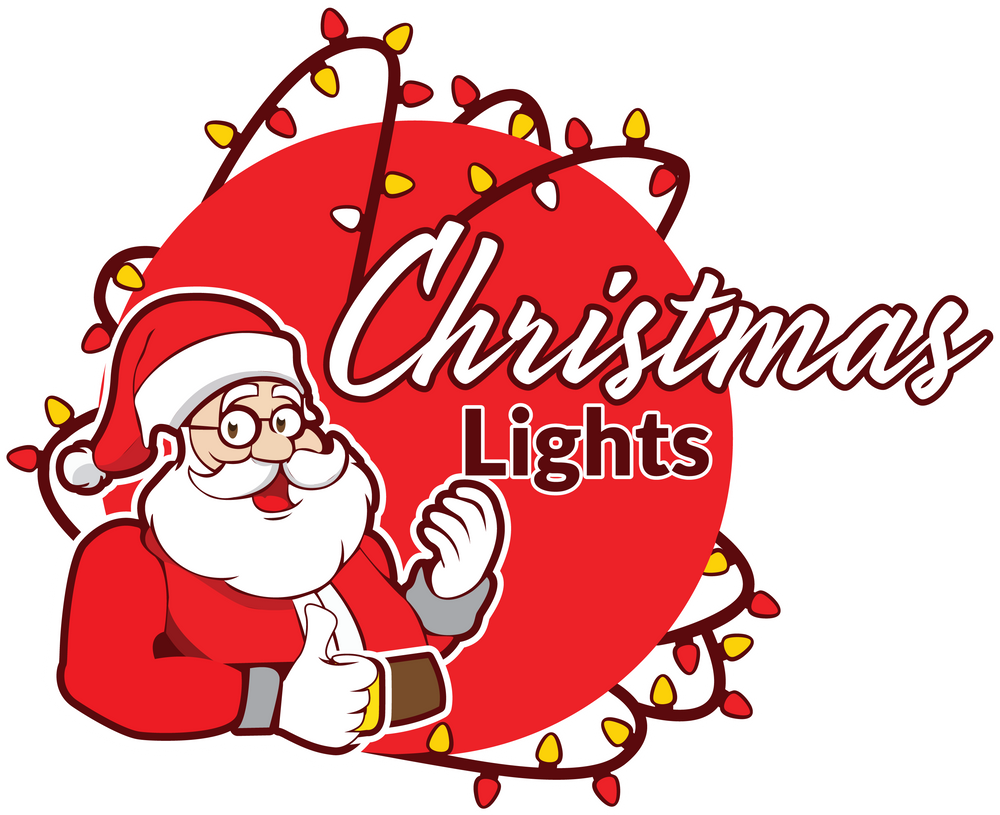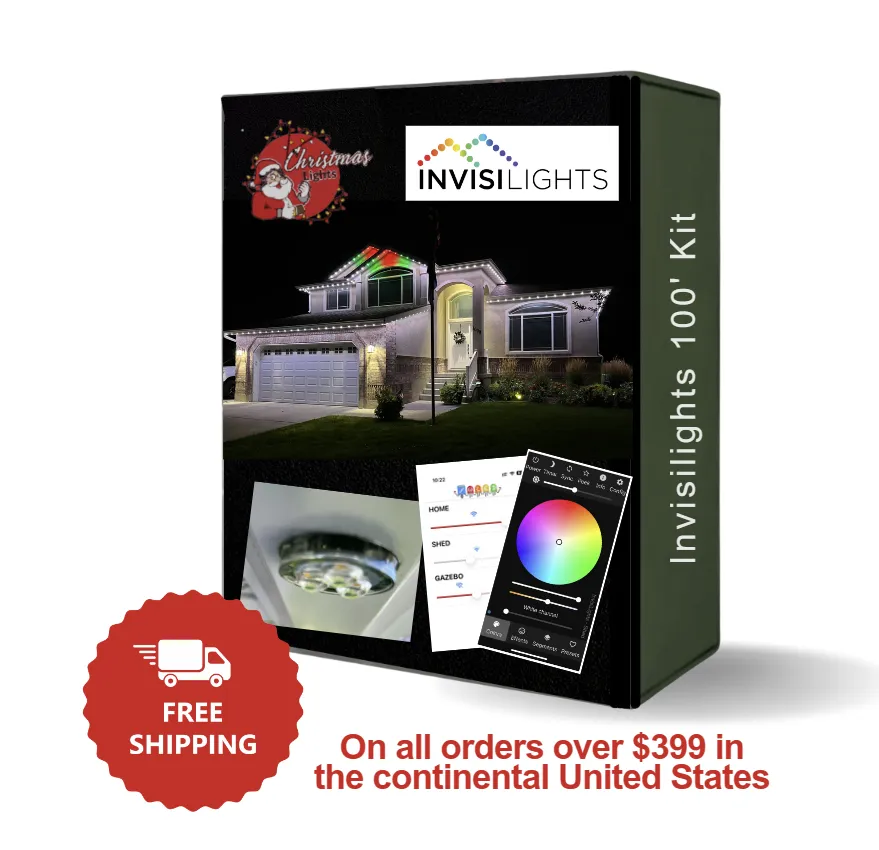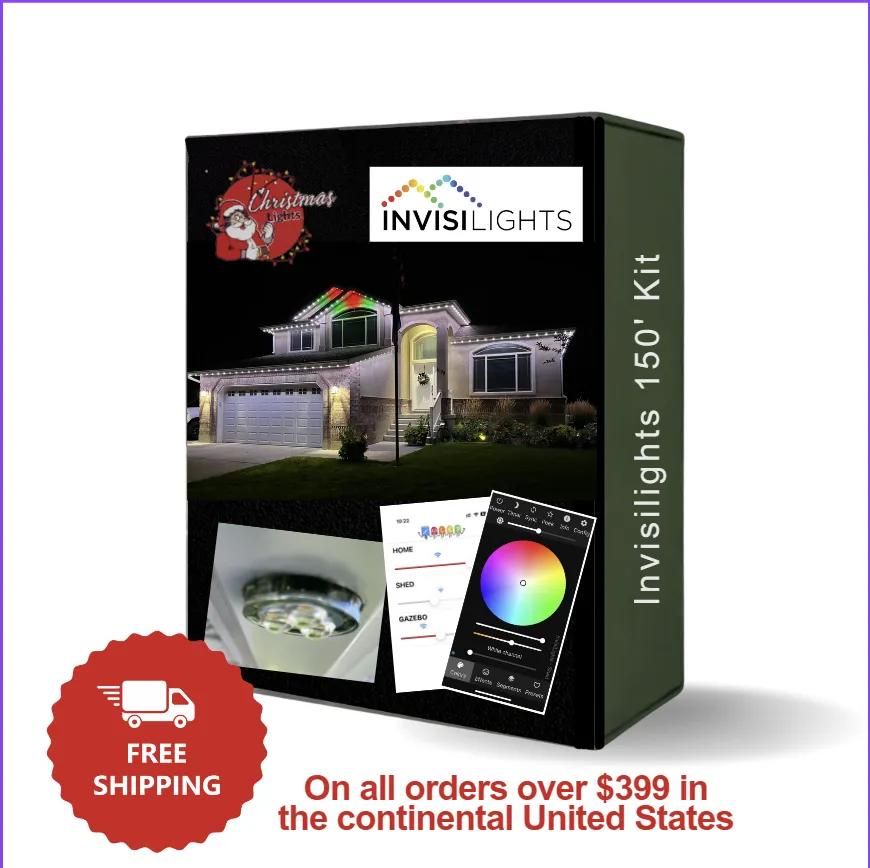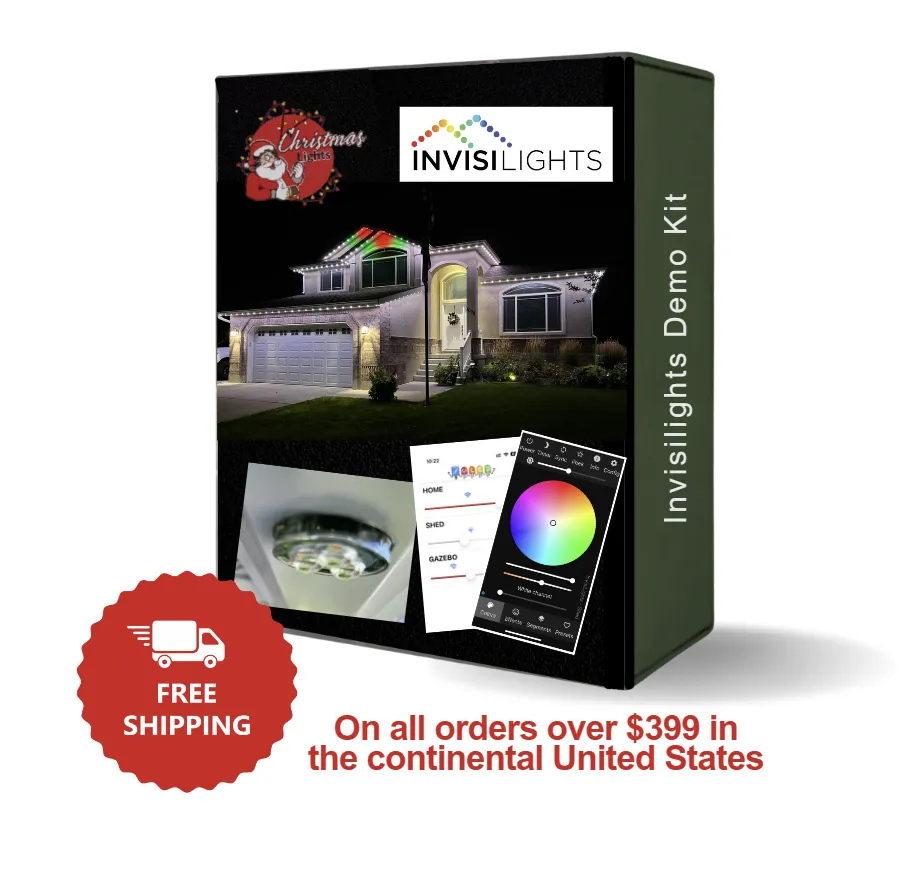Invisilights
Permanent Holiday Lighting
Customizable Lights for Any Event
WHAT YOU NEED TO KNOW BEFORE ORDERING
Total Linear footage of the installation.
This should include footage of lights and channel along with any Extensions or jumps you'll need to make
Where your controller box will be located
This is the most important step to planning out an installation, Without knowing where the controller will be you'll have no way to know the right materials to buy when it comes to extensions and accessories.
What Voltage system you want to use 24V or 36V
This is a decision you will make based on convince and efficiency, the most important factor with this will be the footage of each lighting run. If the total footage of a run is over 100' you'll need to either power inject on that run or switch to the 36V system that can go up to 200' before needing power injection.
Draw a Map
By mapping out the installation you'll be able to better understand and plan out the install giving you a better idea of what all you'll need to purchase to complete the job.
take the measurements from your map and add up the total number of materials you'll need.
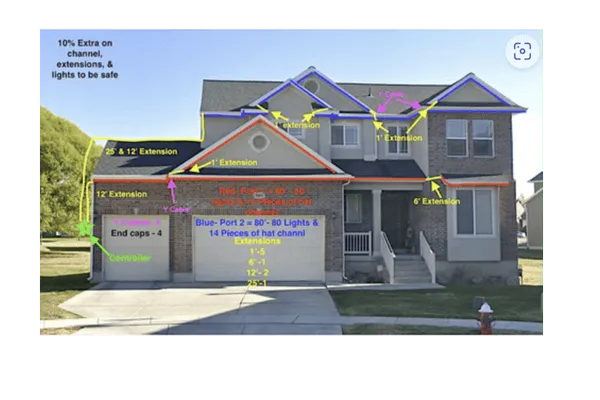
For the Map out example above the total material breakdown is:
System Voltage: 36V
Color of channel: Cameo
Channel Type: Hat
Total Lighted Footage: 160'
Power injection: NO
Controller: 1
Channel: 27- 6' sticks
Screws- 200
Lights: 175
1' extensions-7
6' Extensions-2
12' extensions-2
25- extensions- 1
Y Cables- 3
End caps- pack of 10
Absolute necessities
-Controller
-Lights
-Channel
-Screws
-Extension cables
Other Accessories
-Y Cable
-End Caps
- Signal boosters
-Power injection material
When would you need to power inject?
The controller will come with 3 outputs for your lighting runs, each 36V output can do a Max of 200', the 24V system can do a max of 100'. After that max you'll need to inject power. After you do so you can go an additional 100' with the 24V or 200' with the 36V system.
Power injection is needed due to voltage drop, voltage drop happens due to the length traveled away from the power source along with the gauge of the wire. due to the gauge of wire the lights and extensions run on it drops in voltage enough at 100' with the 24V system and 200' with the 36V system to effect the lights performance requiring a addition of power (Power Injection)
Materials needed for power injection 36V
Power injection pig female pig tale
Power injection Extension cables
Power injection T Cable.
Materials needed to Power inject 24V
16/2 - 12/2 Low voltage landscaping wire
Cut and Splice T cable
Water Proof Wire connectors
Discover the Transformative Power of Invisilights: Expertly Installed Permanent Lighting Solutions
Enhance your installation offerings with Invisilights, the premier permanent lighting solution designed for seamless integration into any property’s exterior architecture.
Crafted with high-quality aluminum channels and advanced LED technology, Invisilights delivers durability and superior energy efficiency—key selling points for your clients seeking long-lasting, cost-effective lighting solutions. Our system not only provides brilliant illumination but also boosts the aesthetic appeal and functionality of any home.
Offer your clients peace of mind with our robust 5-year warranty, ensuring reliable performance and minimal maintenance needs. This warranty supports your commitment to quality and customer satisfaction, making it easier for you to sell and install with confidence.
Our flexible, programmable system allows you to meet any client’s specific desires—from subtle accents to full-scale holiday displays—making it an adaptable choice for various applications. With Invisilights, you can cater to a wide range of preferences and needs, increasing your market reach and customer retention.
Choose Invisilights for your installations and add a transformative product to your portfolio that will impress clients and ensure your services remain in demand for years to come.
Frequently Asked Questions
What exactly comes in the 150' InvisiLights permanent outdoor lighting kit?
The InvisiLights kit is comprehensively equipped to ensure you have everything you need for installation. Each kit includes:
27 sticks of 6-foot Aluminum Channel to house and protect the lighting elements.
150 feet of dynamic RGBW LED Lights, which includes 23 sets of 6-count and 14 sets of 1-count lights, allowing for extensive coverage and diverse configuration options.
2 Data Boosters to enhance signal strength across the lighting installation, ensuring consistent control and color output.
A 320W Power Supply capable of supporting up to 190 puck lights, providing ample power for even the most extensive setups.
1 GFCI Outlet Adapter to ensure safe outdoor electrical connections.
1 Controller that allows you to manage and customize the lighting effects easily.

Will I need any additional components besides what's included in the Invisilights permanent lighting kit?
While the Invisilights kit comes with all the essential components for a standard installation, there are a couple of scenarios where you might need additional items:
Jumper Wires: Depending on the layout of your installation and the number of gaps or 'jumps' between the sections of lights, you may require jumper wires. These wires help bridge the gaps without losing the continuity of the light sequence, ensuring a smooth and uniform display across more complex architectures.
Data Boosters: If any section of your lighting setup is more than 15 feet away from the control box, additional data boosters will be necessary. Data boosters help maintain the integrity and brightness of the lights over longer distances, ensuring consistent performance throughout your installation.
Can I choose the color of the aluminum channel for my InvisiLights kit?
Yes, you can select your preferred color for the aluminum channel to match your home’s exterior or personal taste. Please make sure to specify your color choice in the notes at checkout when you place your order.
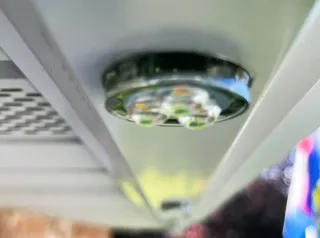
How do the included components of the InvisiLights kit enhance the lighting system?
Each component in the InvisiLights kit plays a crucial role in creating an effective and stunning lighting display:
Aluminum Channels: Provide a durable, weather-resistant housing for the LED lights, which helps in maintaining a clean and nearly invisible look during the day.
RGBW LED Lights: Offer vibrant, full-spectrum color and white light combinations, making it perfect for any occasion from festive holidays to elegant ambient lighting.
Data Boosters: Ensure that the signal remains strong across longer distances, which is crucial for larger installations.
Power Supply: Designed to efficiently handle the energy needs of the system without overload, ensuring safety and durability.
GFCI Outlet Adapter: Adds an extra layer of safety by protecting against electrical shorts and surges, particularly important in outdoor settings.
Controller: Provides the flexibility to customize and control the lighting sequences, colors, and patterns right from your smartphone or controller, adding convenience and advanced functionality to your lighting system.
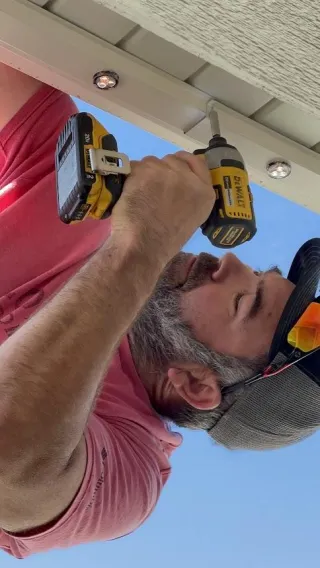
Can I use Invisilights year-round?
Absolutely! Invisilights are designed for versatile use throughout all seasons. Whether you're celebrating a special occasion, setting a mood for a party, Love your favorite sports team, or simply enhancing your home's ambiance, our lighting systems provide the perfect solution for any event, big or small.
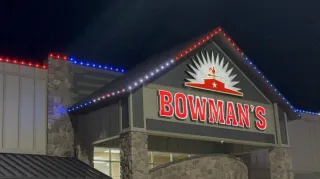
Can I set timers and events for Invisilights?
Yes, Invisilights feature advanced programmable settings that allow you to schedule lighting for specific events and automate timers. This functionality ensures that your lighting preferences are perfectly aligned with your lifestyle, turning on and off at predetermined times without any manual intervention.
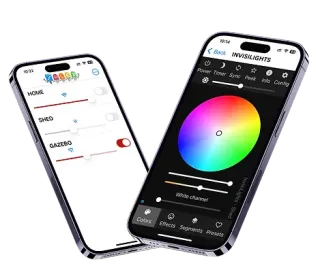
Is it possible to achieve warm or soft white with Invisilights?
Absolutely, Invisilights are equipped with RGBW technology, which includes a dedicated white LED alongside the standard red, green, and blue LEDs. This addition allows the system to produce authentic warm white, soft white, and various other shades of white with greater accuracy and intensity compared to traditional RGB systems. This capability ensures that you can effortlessly tailor the lighting to fit the desired ambiance and aesthetic of any environment, providing precise control over both vibrant colors and the subtlety of different white tones.

How do you ship your product?
Our products are shipped directly from our warehouse using reliable shipping carriers to ensure timely and safe delivery. Each product is securely packaged to prevent damage during transit, and we provide tracking information so you can follow your order’s journey to your doorstep.
Where are the controller and power supplies installed?
The controller and power supplies for Invisilights are typically installed in an accessible location such as a garage or utility room. These components connect to your home’s WiFi network, allowing seamless control over the lighting system via our user-friendly mobile app.
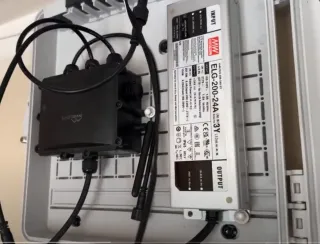
How long do Invisilights last?
Invisilights are engineered to last, with each LED bulb boasting a lifespan of over 50,000 hours. Given a typical usage of 10 hours per night, this translates to approximately 5,000 nights. This means your Invisilights could illuminate your home's exterior for nearly 14 years under these conditions, ensuring that your investment not only adds beauty but also long-term value to your property.
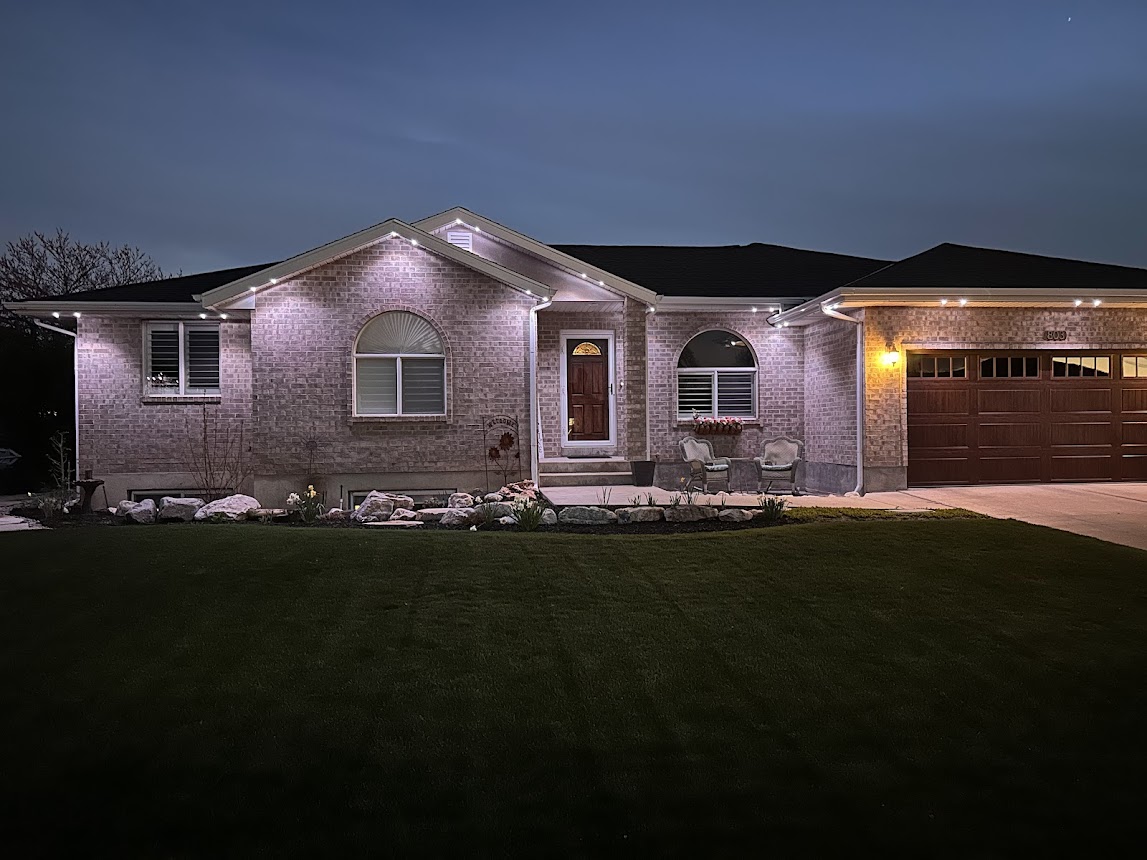
Are Invisilights dimmable?
Yes, all Invisilights are fully dimmable. This feature allows you to adjust the intensity of the light to suit various occasions, from a soft glow for a romantic evening to bright, vibrant colors for a festive celebration.

What types of custom channels are available?
Invisilights offers two types of custom channels, available in 40 different colors, ensuring a nearly invisible installation. These channels are designed to blend seamlessly with your home’s architecture, providing discreet yet effective lighting.

Can I control different zones independently?
Yes, the Invisilights system supports multiple zones which can be controlled independently or synchronized. This functionality allows for intricate lighting designs that can vary across different areas of your home, enhancing the overall impact and utility of your installation.

What is outdoor permanent lighting?
Permanent lighting refers to architectural-grade lighting systems that are installed permanently on your property to provide year-round illumination.
How does permanent lighting differ from traditional holiday lighting?
Unlike traditional holiday lighting, which is typically temporary and used only during specific seasons, permanent lighting is installed once and can be used throughout the year for various occasions
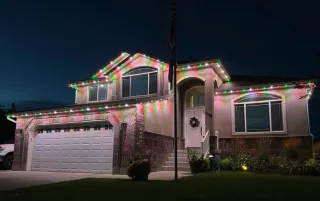
Discover Expert Tips on Our Blog
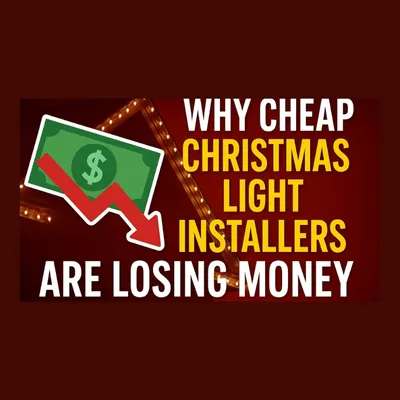
Why Cheap Christmas Light Installers Are Losing Money
The Christmas lighting industry sits at a critical crossroads where operators must decide whether they're building a sustainable business or simply creating another job for themselves. This distinction becomes particularly evident during peak season when the difference between strategic pricing and discount pricing determines not just current profits, but long-term business viability.
Many service providers struggle to understand why their Christmas lighting operations generate revenue without producing actual profit or sustainable growth. The answer typically lies in a combination of underpricing, poor mindset, and failure to recognize the true costs of business operations. Breaking through these barriers requires honest self-assessment and willingness to charge what services are genuinely worth.
The True Cost of Underpricing
When operators charge $6 per foot instead of $8-10 per foot, they often dismiss the difference as minimal—perhaps $200 per job on a typical 150-foot installation. However, this seemingly small difference compounds dramatically across an entire season, representing thousands in lost profit that could fund marketing, equipment upgrades, or business expansion.
The real issue extends beyond immediate profit loss. Underpricing prevents investment in the systems, training, and infrastructure necessary to scale beyond owner-operator status. It creates a cycle where the business owner works constantly but never accumulates resources to hire quality help, implement proper systems, or take the business to the next level.
Hidden Costs That Demand Premium Pricing
Every Christmas lighting business faces numerous expenses that low-pricing strategies fail to cover adequately. Labor costs extend beyond hourly wages to include workers' compensation insurance, payroll taxes, training time, and recruitment expenses. Equipment costs encompass not just ladders and lights but vehicles, maintenance, fuel, and depreciation.
Insurance requirements alone—general liability, workers' compensation, and vehicle coverage—can consume significant portions of revenue. Add marketing expenses, administrative time, customer service, warranty obligations, and unexpected callbacks, and the true cost of each installation becomes substantially higher than many operators realize.
Successful businesses factor all these costs into pricing structures, ensuring each job contributes to overall profitability rather than simply covering direct expenses. This comprehensive approach to pricing creates the financial foundation necessary for sustainable growth.

The Mindset Barrier
The most significant obstacle to premium pricing isn't market resistance—it's the business owner's internal belief system. Operators who convince themselves their market "won't pay" premium prices create self-fulfilling prophecies. This limiting mindset manifests in sales conversations, body language, and presentation quality, subtly communicating doubt to potential customers.
Successful operators in identical markets—sometimes on the same streets—routinely charge $9-12 per foot while their competitors struggle at $6. The difference isn't market demographics or customer capacity to pay. It's the confidence and value proposition the business owner projects during sales interactions.
Developing Premium Pricing Confidence
Building confidence in premium pricing requires understanding that customers don't purchase based primarily on technical specifications or cost per foot. They buy emotional benefits: the joy of creating holiday magic, the convenience of professional service, the peace of mind from proper safety protocols, and the satisfaction of impressing neighbors and guests.
When operators focus sales conversations on these emotional drivers rather than bulb specifications or installation techniques, price resistance diminishes dramatically. Customers willing to invest in premium holiday experiences aren't primarily concerned with comparing per-foot costs—they're evaluating whether the end result justifies the investment.
This shift requires rewiring habitual sales approaches. Instead of leading with technical details about LED efficiency or bulb placement strategies, successful operators ask about holiday traditions, family gatherings, and what the customer hopes to achieve. These emotionally-centered conversations naturally support premium pricing.
Selling Experience, Not Products
The fundamental error many Christmas lighting businesses make involves selling products and services rather than experiences and transformations. Customers don't lie awake at night dreaming about C9 bulbs or SPT wire specifications. They envision magical holiday displays that create memories, impress guests, and express their holiday spirit.
Consider a customer planning a winter wonderland-themed baby shower. The sale isn't about how many feet of lights or which clip style will be used. It's about creating an unforgettable experience for the expectant mother, impressing guests, and generating memories that last a lifetime. When operators understand this fundamental truth, pricing discussions shift from cost justification to value creation.
Practical Application of Experience-Based Selling
During initial consultations, asking the right questions reveals emotional motivators that support premium pricing. Questions about holiday traditions, special occasions, grandchildren visiting, or entertaining plans uncover the true value drivers. These insights allow proposals to be framed around delivering desired experiences rather than simply installing lighting systems.
For example, learning that grandchildren will visit for the first time in years creates opportunities to discuss how professional lighting will enhance those precious moments. Understanding that a customer hopes to win the neighborhood decorating contest frames the proposal around achieving that specific goal rather than generic installation services.
This consultative approach positions the business as a partner in creating desired outcomes rather than a commodity service provider competing primarily on price. Customers willingly pay premium prices when they perceive unique value aligned with their specific goals and emotional drivers.
The Customer Quality Factor
Premium pricing doesn't just improve profitability—it attracts better quality customers. Clients who select services based primarily on lowest price tend to be the most demanding, least appreciative, and most likely to generate callbacks for minor issues. They often request additional services without additional payment and leave negative reviews over small imperfections.
Conversely, customers comfortable with premium pricing typically value quality, appreciate professional service, respect the expertise involved, and become excellent referral sources. They understand that superior results require investment and are more likely to become long-term, returning customers who contribute to sustainable business growth.
Managing Customer Expectations Through Pricing
Pricing strategy sets expectations before the first interaction. When businesses position themselves as premium providers through confident pricing, they attract customers who expect and appreciate professional execution. This alignment creates more satisfying business relationships for both parties.
Lower pricing attracts customers expecting budget results but often demanding premium outcomes—a fundamentally incompatible expectation that generates frustration and conflict. Premium pricing eliminates this disconnect by attracting customers whose expectations align with the service level provided.
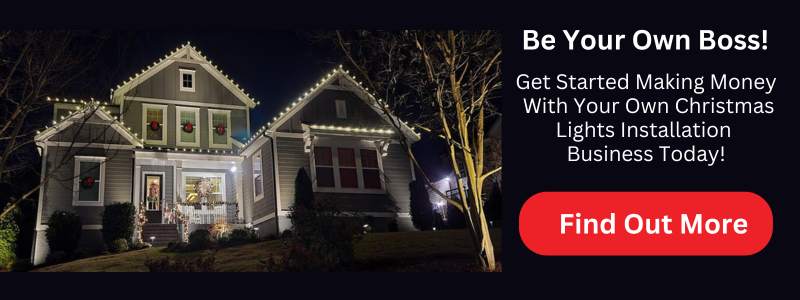
Market Realities and Competition
Every market contains competitors operating at various price points, from budget operators charging $2-4 per foot to premium providers at $12-15 per foot. This range will always exist. The key insight is that different customer segments seek different value propositions—attempting to compete across all segments simultaneously is impossible.
Successful businesses identify their ideal customer segment and align their entire operation—pricing, marketing, service delivery, and communication—to serve that segment exceptionally well. They recognize that trying to be everything to everyone dilutes focus and prevents excellence in any area.
Geographic Considerations
Location within a market significantly impacts pricing potential. Rural areas 45 minutes from metropolitan centers naturally present different dynamics than affluent suburban neighborhoods. Successful operators in less affluent areas often travel to markets supporting premium pricing rather than compromising their business model to serve local budget-conscious customers.
This geographic flexibility requires thinking beyond immediate proximity to consider where ideal customers live. Driving 30-45 minutes to serve premium markets often proves more profitable than working locally at unsustainable prices. The additional travel time becomes insignificant when each job generates substantially higher margins.
The Urgency of Peak Season
The period from mid-October through Thanksgiving represents the critical window for Christmas lighting businesses. This compressed timeframe demands maximum effort in marketing, sales follow-up, and installation scheduling. Backing off marketing during this period because "we're already busy" represents a costly strategic error.
Successful operators maintain aggressive marketing throughout peak season for multiple reasons. Early customers who haven't scheduled yet still represent significant revenue opportunities. Creating urgency through scarcity messaging ("only a few spots remaining") motivates fence-sitters to commit. Most importantly, continuing to build brand awareness and customer engagement during high-visibility season generates referrals and positions the business for subsequent years.
Tactical Execution During Peak Season
Specific actions during this critical period include posting multiple photos daily to social media platforms, recording and sharing video content showing installations in progress, requesting and promoting customer reviews immediately after installation completion, and maintaining aggressive yard sign placement in high-traffic areas.
Many operators make the mistake of reducing marketing when they feel "busy enough." However, the definition of "busy enough" often proves conservative. Pushing beyond comfortable capacity—through extended hours, strategic partnerships, or selective subcontracting—typically reveals that significantly more revenue was available than initially believed.
The compressed season means every day counts. Delays in follow-up, slow quote turnaround, or gaps in marketing consistency represent lost opportunities that cannot be recovered. Speed matters: speed to answer inquiries, speed to provide quotes, speed to schedule, and speed to install all contribute to maximizing seasonal revenue.

Systems and Scalability
Building a business rather than a job requires implementing systems that allow operations to continue without direct owner involvement in every task. This transition represents one of the most challenging phases of business growth but is essential for reaching six and seven-figure revenue levels.
Documented processes for common scenarios—standard residential installations, commercial properties, customer intake procedures, quote creation, and follow-up sequences—allow training employees to deliver consistent results. Without these systems, the business remains dependent on the owner's personal involvement, creating a ceiling on growth potential.
The Revenue Progression Challenge
Most Christmas lighting businesses find reaching $100,000-200,000 in annual revenue relatively achievable with the owner performing most installations alongside one helper. Scaling from $500,000 to $1,000,000 requires fundamentally different operations: multiple crews, administrative support, systematic quality control, and delegation of installation work.
The profitability paradox occurs during this transition. Businesses are often most profitable at $200,000-300,000 with minimal staff, experience a profit squeeze while scaling through $500,000-800,000 as they add overhead, then return to strong profitability beyond $1,000,000 when systems mature and efficiency improves.
Understanding this pattern helps operators persist through the challenging middle phase where adding necessary infrastructure temporarily reduces profit margins. Many businesses stall at $300,000-500,000 because owners resist the temporary profit reduction required to build scalable operations.
Taking Relentless Action
The common thread among successful Christmas lighting businesses isn't luck, location, or special advantages—it's consistent, relentless action execution. While others discuss, plan, and prepare, successful operators implement, test, adjust, and scale. They understand that imperfect action produces better results than perfect planning.
This action orientation manifests in multiple ways: posting content despite discomfort with cameras, placing yard signs even when weather is poor, making follow-up calls when tired, and maintaining marketing momentum when installation demands are high. Each small action compounds with others to create significant results.
Overcoming Analysis Paralysis
Many operators become trapped in endless cycles of research, planning, and preparation without executing. They attend training, join groups, consume content, but never implement what they learn. This pattern provides the comfort of feeling productive without the risk and discomfort of actual action.
Breaking this cycle requires recognizing that learning without implementation produces zero results. The valuable insights aren't in the information itself but in the lessons learned through attempting implementation, adjusting based on results, and iterating toward success. No amount of study substitutes for real-world testing and adjustment.

Q1: How do I justify charging $8-12 per foot when competitors charge $5-6?
A: You don't justify it—you demonstrate value through professional presentation, emotional selling focused on customer outcomes, and confidence in your expertise. Customers willing to pay premium prices aren't comparing per-foot costs; they're evaluating overall value and trust. Focus your marketing and sales conversations on the experience you deliver, not technical specifications or pricing comparisons.
Q2: What if customers say my prices are too high?
A: Price objections usually indicate you haven't effectively communicated value or you're targeting the wrong customer segment. Refocus the conversation on their goals, the emotional benefits they'll receive, and the specific outcomes they desire. If objections persist, they may simply not be your ideal customer—and that's fine. Not every prospect should become a customer.
Q3: When is the right time to stop marketing during the season?
A: Never stop marketing during peak season. Even when you feel fully booked, continue building visibility because you may have been conservative in capacity estimates, cancellations create openings, and maintaining brand presence generates future referrals and positions you for next season. The compressed season means every incremental lead has significant value.
Q4: How do I transition from doing all installations myself to managing crews?
A: Start by documenting your processes for common installation types, create quality standards with photo examples, and recruit carefully from industries like roofing where workers already possess relevant skills. Begin with one reliable helper and gradually expand as you refine training and quality control systems. The transition is challenging but necessary for scaling beyond $200,000-300,000 annually.
Q5: What's the minimum I should charge to have a profitable business?
A: Aim for $8-10 per foot minimum with a $1,000 minimum job size. Anything less makes it extremely difficult to cover true business costs including insurance, marketing, quality equipment, proper labor rates, and administrative time while generating actual profit. Many successful operators charge $10-15 per foot depending on complexity and market positioning.

Q6: How important is having professional equipment and appearance?
A: Very important. Professional appearance—wrapped trailers, quality uniforms, well-maintained equipment—justifies premium pricing and serves as mobile marketing. Customers associate visible professionalism with quality service. The investment in professional presentation typically pays for itself through increased close rates and reduced price resistance.
Q7: Should I focus on volume or higher-priced jobs?
A: Higher-priced jobs with fewer total installations generate better profitability and customer quality. Five $2,000 installations produce $10,000 with less total work and administrative overhead than twenty $500 jobs. Premium pricing also attracts customers who value quality, generate fewer callbacks, and provide better referrals.
Q8: How do I find customers willing to pay premium prices?
A: Target affluent neighborhoods through strategic yard sign placement, focus marketing messaging on experience and convenience rather than price, and ask qualifying questions early in the sales process. Let your pricing naturally filter customers—those who immediately focus on price comparisons typically aren't ideal clients. Your ideal customers exist; you need marketing that reaches them.
Q9: What if I'm already booked but keep getting leads?
A: Increase prices for new customers, create a waiting list, consider strategic partnerships or subcontracting, or extend your season. Getting "too many leads" is a high-quality problem indicating strong demand. Rather than turning business away, explore ways to capture additional revenue through creative solutions or use it to justify price increases for future seasons.
Q10: Is it too late to start for this season?
A: It's rarely too late if you take immediate, aggressive action. Focus on door-to-door sales, quick quote turnaround, and immediate installation scheduling. Some operators have started in late October and still achieved strong first-year results. However, earlier starts provide more time for systematic marketing and customer acquisition. For next season, begin preparation and marketing in late summer.
Copyright ©2025 All Right Reserved website designed by christmaslights.io
Terms of Service / Privacy Policy
Have questions or need assistance?
Contact us at (855)619-LITE
